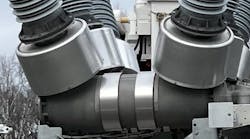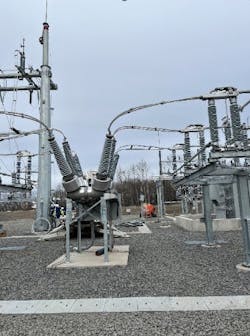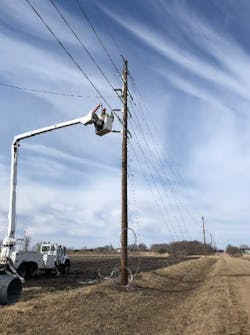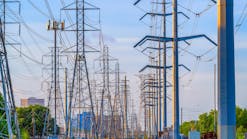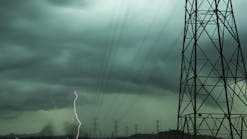Weather has been and always will be the greatest threat to electricity infrastructure and reliable service. Great River Energy, an electric generation & transmission cooperative that serves two-thirds of the geography of Minnesota, U.S., is accustomed to operating its 5,100 miles of transmission lines and more than 100 substations in sub-zero temperatures throughout the winter months. Despite 2024 having been a relatively mild season overall, the cooperative has been well prepared for the challenges that bitter temperatures and extreme winter weather can bring. Just a few steps the cooperative takes to ensure its system can stand up to inevitably harsh winter conditions include the following:
Heated circuit breakers
Great River Energy’s transmission lines and substations are designed to operate through weather extremes. Circuit breakers have heating elements in them so they can be warmed in winter. Warming the circuit breakers is necessary as they contain SF6 gas, which can liquefy and lose effectiveness at extreme cold temperatures. Great River Energy recently changed its circuit breaker operating temperature specification from -40C to -50C for its entire service territory to ensure reliable operation in the dead of winter.
“Twisted pair” conductor minimizes galloping
Ice build-up on transmission lines in Minnesota can cause galloping in windy conditions and wreak havoc on reliability if the conditions are right. This bouncing or bucking movement on overhead lines can cause several problems. Using twisted pair conductor, which is designed to minimize galloping and other conductor motion, is now a standard when Great River Energy constructs new transmission lines or rebuilds in areas where ice and wind are more likely to cause galloping. Twisted pair conductor is constructed with two identical bare conductors twisted together. This twisting shape reduces movement that can cause bare conductor to gallop.
Weather threat assessment
Four seasons of Minnesota weather brings a wide variety of conditions. Great River Energy recently assessed how a changing climate impacts the future likelihood and geographic dispersion of five weather risks relative to historical location and occurrence. These weather risks include wind, ice storms, lightning, wildfires and flooding. The insights gained help the cooperative identify where and when mitigation measures could most effectively bolster their transmission system. The results of this effort influenced numerous engineering design standard changes recognizing the potential fluctuations in the climate landscape over the lifetime of these assets.
Transmission structure analysis
Transmission line engineering has been integrating the use of self-supporting steel structures on foundations as opposed to wood poles with guying to improve transmission line infrastructure resilience related to winter weather conditions. This has included analyzing various geographic and service criteria to determine if self-supporting dead-end structures should be added to reduce the chance of failure. Self-supporting steel structures are also being used for mounting line switches to reduce the probability of varying temps and ice causing these switches to be out of alignment. Direct embedded pole depths are designed to account for soil conditions that will vary throughout the service area. The embedment depth takes into account larger conductor, increased loading conditions and soil borings to ensure structures have a solid foundation.
Recovery plans and trained personnel
Great River Energy has a newly updated plan for major storm response. Employees participate in drills annually to ensure they are well trained. The cooperative also has mutual aid agreements with other utilities in the region to ensure outside assistance is available if needed. Employees from Great River Energy’s 27 member-owner distribution cooperatives are trained annually on how to operate Great River Energy’s switches so they can help re-route power locally and minimize response time when needed.
Technology
Great River Energy’s energy management system, which is used to operate power lines and substations, displays information about the current state of the system. A dashboard that displays information on Great River Energy’s geographic information system shows operators live weather data including lightning strike locational information and ampacities. This dashboard includes an ice and wind forecasting application to predict ice accumulation that could possibly damage transmission lines. The dashboard can display relay fault location data obtained from the energy management system so operators can quickly identify probable fault locations and isolate sections of power lines to restore impacted members.
Power plant weatherization
Great River Energy operates and maintains 10 dispatchable power plants across Minnesota and North Dakota. The cooperative also has a large amount of wind and hydroelectric energy under contract. These power plants and facilities are designed to operate in extreme cold and hot temperatures and have consistently performed well. As weather becomes more extreme, steps are being taken to further assure the plants operate in the bitter cold. Great River Energy has added more insulation and provided heat trace to exposed equipment. The cooperative also uses arctic-level grease and oils where needed.
For more information about Great River Energy, visit greatriverenergy.com.
Mark Peterson is the manager of system operations at Great River Energy, where he has been employed since 1999. Peterson’s department is responsible for control center operations, operational engineering functions and energy data management. Peterson received his BSEE degree from North Dakota State University in 1993 and is a registered professional engineer in the state of Minnesota.
